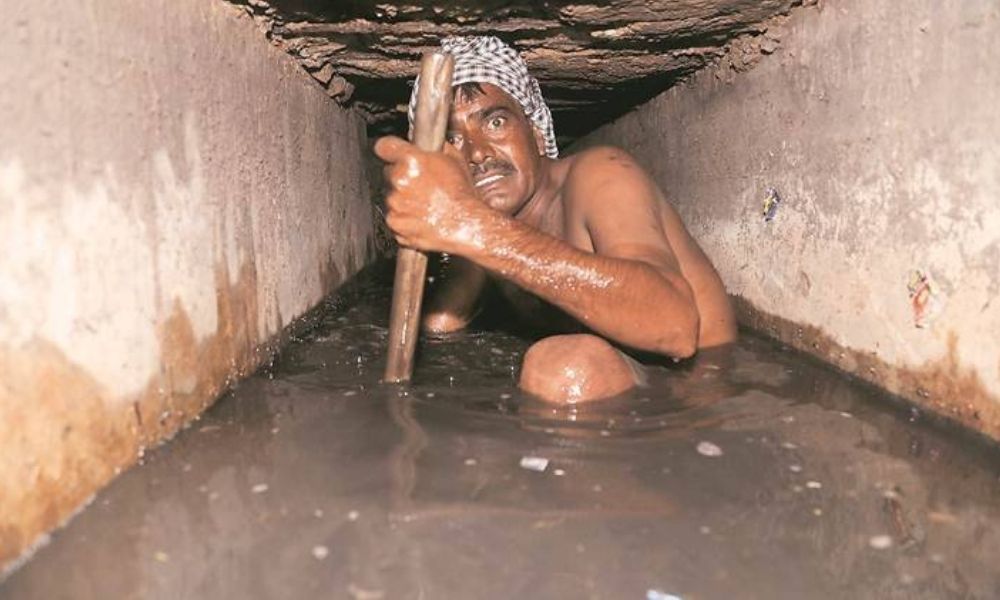
Image Credit: The Indian Express
Why Is Manual Scavenging Still A Problem For India?
Writer: Ratika Rana
Her primary objective is to inform, promote, educate and cultivate readers through writing.
India, 6 Aug 2021 4:31 PM GMT
Editor : Madhusree Goswami |
A mountain girl trying to make it big in the city. She loves to travel and explore and hence keen on doing on-ground stories. Giving the crux of the matter through her editing skills is her way to pay back the journalism its due credit.
Creatives : Ratika Rana
Her primary objective is to inform, promote, educate and cultivate readers through writing.
The Centre informed the Parliament that nobody succumbed to manual scavenging in the country. However, 941 workers died in the last three decades died while cleaning sewers and septic tanks.
The act of manually cleaning, carrying, disposing or handling human excreta is often referred to as manual scavenging in India, mainly. While this remains a known fact, the government informed the Parliament on the August 4 that no one succumbed to manual scavenging in the country, but 941 workers died during the last three decades while cleaning sewers and septic tanks.
An Open Secret
Manually collecting human faeces by sanitation workers is banned in our country since 1993 under the Employment of Manual Scavenging and Construction of Dry Latrines (Prohibition) Act. However, manual scavenging is nothing less than an open secret in Indian society. It is very prevalent and continues to act as a source of livelihood for many. Manual scavengers are one of the most disadvantaged and most impoverished communities to exist. While many of us have witnessed the heinous job of manually cleaning septic tanks and sewer systems, the crime remains underreported even in metropolitan cities like Bengaluru and Mumbai. Various state governments have even launched helplines to register cases of manual scavenging. Regardless, the response for the same has not been up to mark.
The stigma and discrimination associated with such employment make it difficult for manual scavengers to secure alternate livelihoods. Due to a lack of such opportunities, many find themselves unable to support their families. Even today, many latrines across the country are connected to open drains and septic tanks that need regular manual cleaning. Even when state governments provide various municipal corporations with suction machines that act as a great alternative, people prefer appointing manual scavengers.
Identification And Rehabilitation
To identify manual scavengers and provide them rehabilitation, the government of India replaced the 1933 Act with the Prohibition of Employment as Manual Scavengers and their Rehabilitation Act. Analyzing the data provided by the government, Tamil Nadu reported the highest such deaths at 213, followed by 153 deaths in Gujarat, 104 deaths reported in Uttar Pradesh, 98 deaths in Delhi, 84 deaths reported in Karnataka, and 73 deaths in Haryana.
Under the Scheme for Rehabilitation of Manual Scavengers (SRMS) set up in January 2007, a one-time cash assistance of ₹ 40,000 will be directly deposited into the accounts of all the identified and eligible manual scavengers. However, the issue here is that not all manual scavengers across the country have been identified and recognized by the government. There are so many manual scavengers who will never be eligible for all the government's schemes and rehabilitation programs.
Since the Safai Karamchari Andolan (SKA) constitution in 1994, many manual scavengers have been identified in India. A report by the watchdog organization stated that Bengaluru alone houses more than 30,000 to 50,000 manual scavengers. "Our estimate is based on the 2011 census data for the Bruaht Bengaluru Mahananagara alikeP area. As per the census, in Bengaluru, 79.3 per cent of households are connected to the underground drainage (UGD) system. The rest are single-pit or septic tank latrines, which are manually cleaned. This translates to over four lakh toilets, which are cleaned manually," Siddharth KJ, member of SKVS, told The New Indian Express. Sanitation workers also double as manual scavengers owing to their financial woes, he added.
Union Social Justice Minister, Virendra Kumar, told the Rajya Sabha that there were 58,098 manual scavengers identified in India in two separate surveys in 2013 and 2018. Nonetheless, the number of manual scavengers dropped to 42,303 in 2018 from 770,338 in 2008. The drastic reduction in these numbers even after the prevalent caste-based practice only highlights the under-assessment rather than reflective of their actual numbers.
Caste and Manual Scavenging
As per the 3,000-year-old caste system, the brahmins, Kshatriya, Vaisya, and the Shudras, the four varnas that created the caste hierarchy. These varnas comprised thousands of sub-groups within themselves. Each of these sub-groups had its specific occupation imposed on them.
The concluding caste in this hierarchy was that of the untouchables. People who belonged to this caste were considered separate from the varnas. They were more often looked upon as outcasts. One of the primary reasons for treating them differently was dealing with dirty waste and more. Also known as 'Bhangi', a Sanskrit word that translates to 'Broken'. The Hindi translation for 'Bhangi' is trash.
Unfortunately, this practice is still prevalent to date and is highly under-reported.
Health issues that come with manual scavenging
According to a study conducted by the Centre for Education and Communication in 2005 in Delhi (featuring 200 workers), snitation workers have a lower life expectancy than the average population. Few of them live beyond 60, and there is a decline in the number of those who are above 50.
TISS had submitted a report where the workers avoided safety gear like masks and gloves as they were not user friendly and were of poor quality. Sewers and septic tanks are home to toxic gases like ammonia, carbon monoxide, and sulphur dioxide. Coming in direct contact with these would cause unconsciousness and even death. Manual scavengers also risk cardiovascular degeneration, musculoskeletal disorders, infections, leptospirosis, skin problems, and respiratory system problems. Since the very act of manual scavenging leads to co-morbidities like the ones mentioned above, this profession makes them much more vulnerable to the Covid-19 virus.
There is also a stigma attached to the act of manually handling human excreta. Their families face a lot of harassment in Indian society. The only way forward is through judicial intervention and proper assessment of how prevalent manual scavenging is. Society in general needs to take special cognizance of the issue and report to the authorities when the practice comes to notice. There are ample mechanizations that can act as an alternative to eradicating the manual handling of faeces. All those engaged in this undignified practice must be rehabilitated and educated about the health issues that come with manual scavenging. The tendency of under-reporting by the government needs to be assessed. The government must ensure proper disbursement of compensations upon death to the respective families. There is a requirement to involve different officials and actively encourage community initiatives to irradicate the practice from the root level.
Also Read: Uttarakhand To Pay Tribute To COVID Warriors With Freedom Fighters On Independence Day
 All section
All section














